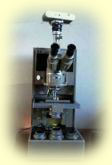
Race schedule for the year 2002:

A record of daily management details will be found in the pages of the ![]() Alberta Classic Diary.
Alberta Classic Diary.
Darkening will begin at the time of the birds' arrival. The daylight hours will initially be between 11:00 hours and 21:00 hours and changed gradually to be between 08:00 hours and 18:00 hours. ( A small light will always be on in the loft so that the birds can still find the water during the "night time". However, it will still be at least as dark as under a star lit sky. )![]() The daily exercise period will be between 08:10 hours and 09:10 hours during the darkening period except in inclement weather.
The daily exercise period will be between 08:10 hours and 09:10 hours during the darkening period except in inclement weather.
We will train these youngsters up to 50 miles prior to the first race and give 30 mile tosses between races.
There will again be 4 races and we will use the cumulative time for determining the winners. We will try to test these pigeons from longer distances as one is normally used to but we will always strive for races which a large proportion of birds can fly on the day. It would be easy to organize races in which 90% or more birds arrive together. However, such a schedule would not tell us anything about the sporting quality of the birds and would be akin to the German system of 5 to 6 races up to 250 km. I am certain that those fanciers keep a lot of inferior racing pigeons over winter and lose them the following year as yearlings. The crucial testing as youngsters was absent. Because of the high losses of yearlings resulting from such a short sighted approach, voices calling for shorter yearling races (i.e. 450 km) can be heard. And how far do they send their yearlings? Just over 600 km. This distance needs to be compared to the final race of 850 km the 2001 Alberta Classic youngsters had to fly!
The problem in Germany actually seems to originate with those who think that a race needs to be scheduled from a definite geographic point regardless of the prevailing weather. It should therefore surprise nobody that a 650 km race with 30 to 50 mile/hr headwinds can have catastrophic consequences, and this in an age when the weather satellites constantly beam down all kinds of useful and current data. I considered 400 km in 2001 to be an adequate test under those conditions. But let's get back to the proposed 2002 management:
The birds will be separated into adjacent sections and trained separately once they become sexually active.
The above is our intention for the year 2002. We'll also include ![]() TS-6 probiotics which, being derived from very healthy pigeons and able to colonize the intestinal tract of pigeons, will not lead to the symptoms of
TS-6 probiotics which, being derived from very healthy pigeons and able to colonize the intestinal tract of pigeons, will not lead to the symptoms of ![]() "stagnant fluid in the crop" like some other probiotics used previously.
"stagnant fluid in the crop" like some other probiotics used previously.
I have noticed in past years that problems with Adenovirus/E.coli infections reared their ugly heads only after the birds went down onto the ground and started pecking at various things. To prevent the possible contribution to disease of what the yougsters pick up from the ground, this year's birds will not be allowed to land on the ground. They will either be in the air or in the loft. ( ![]() but please see below! )
but please see below! )
- They will also get the following additions for each 4 liters of water:
- ¼ tsp Revibe (glucose and electrolytes) to keep our TS-6 happy
- ¼ tsp Electrolytes Plus
- ¼ cup of
 TS-6 yogurt
TS-6 yogurt
Any deviation from the above will be found on the daily entries of the
It was hoped that we could manage this year's youngsters without the use of antibiotics ( except a course of anti-trichomonals ), but this was naive. The birds arrive here stressed from the trip and stressed from the strange environment among hundreds of other youngsters. Some have not been taught to eat and drink and may go for some additional days without water. Each of them represents a little bag filled with intestinal bacteria of a multitude of various kinds and does not need to pick up any from the environment to become sick. Please have a look at the diary ( May 22 & 23 ) and check out the problems encountered just a couple of days after the birds' arrival. It is fortunate that a combination of Doxycycline, dextrose & electrolytes, and multivitamins ( to substitude for the vitamins not produced by the now removed intestinal bacterial flora ) is effective in helping these little ones.